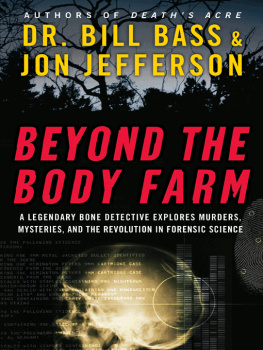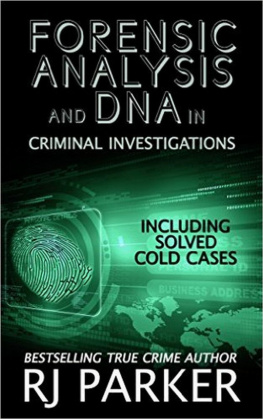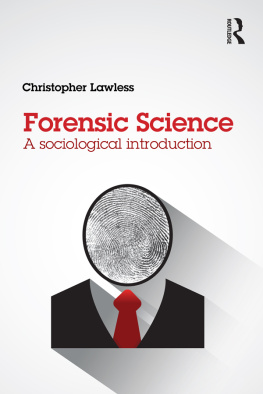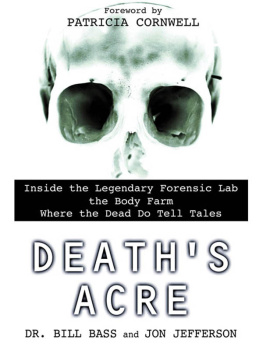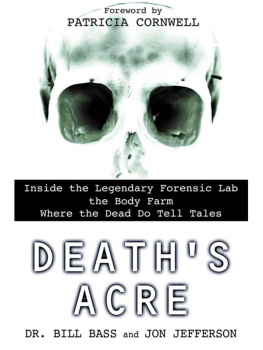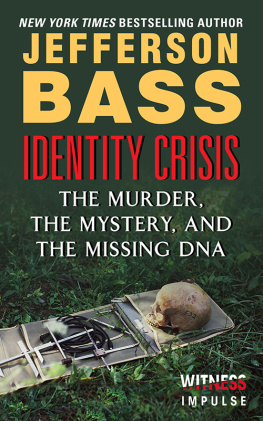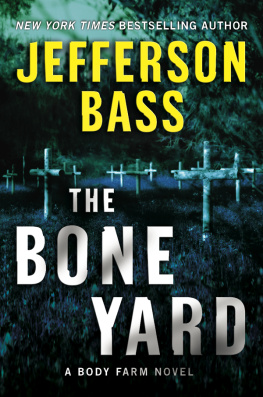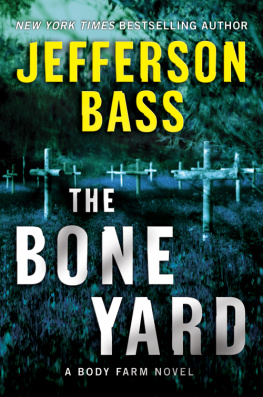DR. BILL BASS AND JON JEFFERSON
A LEGENDARY BONE DETECTIVE EXPLORES MURDERS, MYSTERIES, AND THE REVOLUTION IN FORENSIC SCIENCE
In memory of Dr. Wilton Krogman and
Dr. Charlie Snow, pioneering forensic
anthropologists and inspiring teachers
One April morning fifty-one years ago, Charlie Snow, my anthropology professor at the University of Kentucky, walked into the bone lab as I was hunched over a tray of bones, and asked if I would like to come along on a human identification case. In that one moment, Dr. Snow changed the course of my life and my work forever.
Dr. Snow had been asked by a lawyer whether he could determine the identity of some burned human remains found in a truck outside Lexingtonremains found in the charred cab alongside those of the driver. Both the driver and his passenger (believed to be his common-law wife) had been killed when an A&P grocery truck crossed the highway centerline, causing a fiery collision that killed all three people in the vehicles. Dr. Snow told the lawyer that, yes, he could certainly tell whether the burned remains were indeed those of the drivers common-law wife, provided the womans dental records could be found. It wasnt an idle boast; as director of the U.S. Armys Central Identification Laboratory, Dr. Snow had spent years, during and after World War II, identifying the decomposed, fragmented, and incinerated remains of American soldiers. Snow was in the vanguard of a specialty that decades later would come to be called forensic anthropology: using the knowledge and techniques of physical anthropology, which traditionally focuses on the study of ancient human bones, to help solve crimes, especially by identifying unknown murder victims and determining how they were killed. Even if its not possible to identify a victim by nameand I have a shelfful of skeletons where that wasnt possiblea forensic anthropologist can still help by giving the police details about the victims race, sex, stature, handedness (muscle attachment points tend to be bigger in a right-handed persons right arm, not surprisingly), and manner of death: was the victim stabbed, shot, strangled, bludgeoned, or killed in some other manner that left telltale marks on the bone?
One reason Dr. Snow invited me to accompany him on that life-changing identification case was because I had a car and he did not, though I like to believe the car was far less a factor than my budding brilliance with bones. At any rate, I drove us to the rural church cemetery where the passenger had been buried. The remains inside the waterlogged coffin were slimy and smellya far cry from the lustrous ivory-colored bones Id been studying in the lab the day before. In fact, when the coffins lid was opened, the sight and the smell were so overpowering that I promptly threw up.
That was fifty-one years and hundreds of forensic cases ago. Im happy to report that over the intervening years, I have never again thrown up during a forensic case. Im also happy to report that over those same years, the forensic sciencesthe crime-solving versions of anthropology, entomology, odontology (dentistry), genetics, and other sciences that help catch and convict killershave made quantum leaps, advancing in ways I could not have imagined as I doubled over in that muddy Kentucky cemetery beside Dr. Snow.
I dont mean to imply that forensic science, or forensic scientists, were primitive or backward in the 1950s. After studying with Dr. Snow at Kentucky, I went to the University of Pennsylvania, where I did my Ph.D. studies under Dr. Wilton Krogman, who was internationally renowned as a bone detective. Krogman wasnt called a forensic anthropologistthat term hadnt been coined yetbut Ive never seen anyone better, before or since, at finding clues in human bones: at listening to the secrets the dead can whisper to reveal who they once were and how they were killed. Krogmans particular area of expertise was the skeletal growth and development of children, especially their teeth. For this reason, he tended to have dozens of orthodontists studying under him at any given time. During my years at Penn I was virtually the only forensic anthropologist he taught, and although I didnt have formal training in dentistry or orthodontics, I absorbed a wealth of knowledge about human teeth, especially how they could shed light on a murder victims age and identity.
One of the most important lessons Ive learned during my career is that justice is a team effort. In the course of any given murder case, that team may include uniformed police officers, plainclothes detectives, crime scene and lab technicians, fingerprint experts, medical examiners (forensic physicians, you might say), firearms and ballistics examiners, toxicologists, forensic dentists, and DNA specialists.
From a broader perspective, though, forensic teamwork extends not just across scientific specialties but across decades of research and innovation. I stand on the shoulders of the towering Dr. Krogman; for his part, Krogman stood on the shoulders of T. Wingate Todd, a legendary anatomist at Case Western Reserve University in Cleveland, and the first scientist to note that as we age, our pubic bones undergo steady, consistent changeschanges that can indicate the age of an unknown skeleton. Other early giants in adapting the techniques of archaeology and anthropology to shed light on modern murders included Ales? Hrdlika and T. Dale Stewart, physical anthropologists at the Smithsonian Institution. Between the 1930s and the 1960s, Hrdlika and then Stewart consulted on hundreds of cases for the Federal Bureau of Investigation, which was located just a bones throw away from the Smithsonian. In the process, theylike Krogmanhelped define the tools, techniques, and capabilities of forensic anthropology.
In 1972 the Physical Anthropology Section of the American Academy of Forensic Sciences held its first meeting; five years later, a handful of us created the American Board of Forensic Anthropologists. At one point in my career, Id trained roughly two-thirds of Americas board-certified forensic anthropologists; now, since Ive retired and other teachers have continued to turn out Ph.D.s, that percentage is lower. Still, if you look at the family tree of forensic anthropology, the limb that hangs down below my name is a gratifyingly big one, branching into scores of respected namesscientists working at institutions as varied as the Smithsonian Institution, the Central Identification Laboratory, the Federal Bureau of Investigation, the Georgia Bureau of Investigation, the Kentucky medical examiners office, and numerous universities, including (of course!) the University of Tennessee, which has one of the premier forensic anthropology programs in the world.
The centerpiece, or at least the most famous component, of UTs forensic anthropology program is, of course, the Anthropology Research Facility, which is far better known (to the chagrin of some of my younger colleagues) as the Body Farm. Im often asked how and why I created the Body Farm. I wish I could answer that the vision sprang, full-blown, into my brilliant academic brain, but the fact is, like many scientific journeys, this one unfolded a step or two at a time. From 1960 to 1971, I taught anthropology at the University of Kansas at Lawrence, and during those eleven years, I sometimes identified skeletal remains for Kansas law enforcement officials, ranging from local police to the Kansas Bureau of Investigation; eventually I became friends with Harold Nye, who played a key role in catching the killers profiled in Truman Capotes true-crime classic, In Cold Blood , and who later became director of the KBI.

